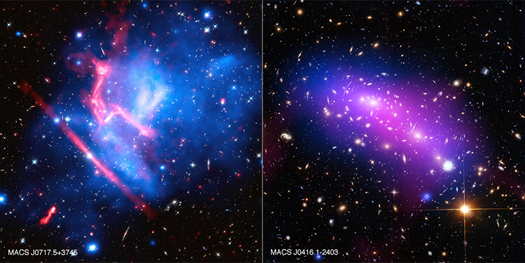Telescopes Combine to Push Frontier on Galaxy Clusters
Galaxy clusters are enormous collections of hundreds or even thousands of galaxies and vast reservoirs of hot gas embedded in massive clouds of dark matter, invisible material that does not emit or absorb light but can be detected through its gravitational effects. These cosmic giants are not merely novelties of size or girth - rather they represent pathways to understanding how our entire universe evolved in the past and where it may be heading in the future.
To learn more about clusters, including how they grow via collisions, astronomers have used some of the world's most powerful telescopes, looking at different types of light. They have focused long observations with these telescopes on a half dozen galaxy clusters. The name for this galaxy cluster project is the "Frontier Fields".
Two of these Frontier Fields galaxy clusters, MACS J0416.1-2403 (abbreviated MACS J0416) and MACS J0717.5+3745 (MACS J0717 for short) are featured here in a pair of multi-wavelength images.
Located about 4.3 billion light years from Earth, MACS J0416 is a pair of colliding galaxy clusters that will eventually combine to form an even bigger cluster. MACS J0717, one of the most complex and distorted galaxy clusters known, is the site of a collision between four clusters. It is located about 5.4 billion light years away from Earth.
These new images of MACS J0416 and MACS J0717 contain data from three different telescopes: NASA's Chandra X-ray Observatory (diffuse emission in blue), Hubble Space Telescope (red, green, and blue), and the NSF's Jansky Very Large Array (diffuse emission in pink). Where the X-ray and radio emission overlap the image appears purple. Astronomers also used data from the Giant Metrewave Radio Telescope in India in studying the properties of MACS J0416.
The Chandra data shows gas in the merging clusters with temperatures of millions of degrees. The optical data shows galaxies in the clusters and other, more distant, galaxies lying behind the clusters. Some of these background galaxies are highly distorted because of gravitational lensing, the bending of light by massive objects. This effect can also magnify the light from these objects, enabling astronomers to study background galaxies that would otherwise be too faint to detect. Finally, the structures in the radio data trace enormous shock waves and turbulence. The shocks are similar to sonic booms, generated by the mergers of the clusters.
More information at https://chandra.si.edu/photo/2016/frontier/index.html
-Megan Watzke, CXC

